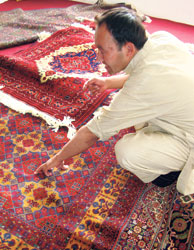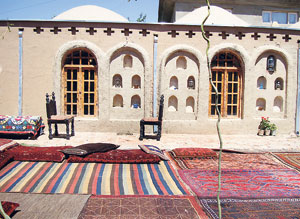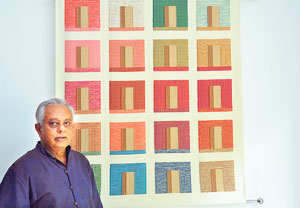On the table in front of us is a collage of photographs: the entrance to the famous Kabul Coffee House guarded by a good looking Afghan and a hefty stack of sandbags; a master dyer leaning on his stick; the cool interiors of a famous Afghan carpet studio; an exquisite mosque built with stones the colour of aquamarines.
 |
Rich heritage: The intricate designs of an Afghan carpet and centre, the famous Afghan
carpet studio |
“There, they made me carry all of that onto the plane,” says Tilak Samarawickrema finally finding the picture we were looking for. In it, the artist and architect is incongruously clothed in a heavy bulletproof vest. He squints out at the world from under a Spartan flak helmet. The big black backpack slung over his shoulder looks heavy. Loaded with food and first aid, the bag was his constant companion in Afghanistan. Courtesy international headlines, the name of this country has been synonymous with war and tumult, but Tilak is here to help revive an art that inspires much pleasanter associations – carpet weaving.
In 1992, a younger Tilak launched an exhibition of gorgeous tapestries in Milan – filled with bold, geometric patterns and vivid colours, the tapestries done by traditional weavers working under his artistic direction. Having taken his designs from a remote village in Sri Lanka to the MOMA design store (where they were sold for nearly a decade), Tilak saw the exhibition make its way across the globe to several prominent museums and galleries. His designs achieved a fine balance between east and west – sharp modern lines inspired by the Bauhaus movement met the vivid colours of Sri Lanka’s ancient cultural artefacts. It was this very sensibility that his new employers wanted him to bring to a new design facility, to be known as the Kabul Design School.
Modern Afghanistan boasts a population of just over 25 million, of these an estimated six million – from sheep herders to the large producers - make their living off the carpet industry, explains Tilak. Of late, an exodus has left the country the poorer as weavers moved to Pakistan and India in the wake of political instability. Thirty years of conflict and some of the most unforgiving terrain in the world have kept globalisation at bay, and today many carpet weavers still belong to nomadic tribes. They gather the yarn from their own herds, but the need to pack up and move on has led to the creation of a flat loom that can be easily dismantled. However, it is the vertical loom that is known to produce the finest carpets.
The skill of Afghan artisans is legendary - among the professional weavers, some do not even need to be given an actual pattern to work with, simply its name will suffice. Still, even with multiple weavers working together each carpet might take upwards of six months to create. The knots that make up the design determine its intricacy. “In a square inch, there can be anything from 40 to 200 knots,” says Tilak explaining that the more knots there are, the smoother the pattern. Natural dyes used by rural weavers add to the beauty of the carpets. In these the patina of age is soft and the colour tones gentle in sharp contrast to the bright artificiality of the chemical dyes.
Through the month he spent there this summer studying the industry, Tilak has one big regret – that he never had a chance to speak with some the most accomplished weavers. Female weavers are the norm in Afghanistan as is the rule that women are segregated from men. Though he never had an opportunity to study them at work, Tilak says “the fabric of the Afghan culture is interwoven with these women.” Clad in their bright blue burqas they can be spotted in a marketplace and in Kabul young girls in jeans and headscarves are a common sight. But rural Afghanistan is a different world. On a trip to Jalalabad, he found that he was to be accompanied everywhere by an armed escort, and that all the houses were out of bounds. “It’s very difficult to get access to an Afghan home,” says Tilak, ruefully.
 |
Luckily, Jalalabad offered other attractions. Tilak’s trip, initiated by The International Executive Service Corps (IESC) in Washington was part of a USAID project. USAID had recently set up several mechanised plants in Jalalabad that were meant to take care of the messy work of post-weaving, especially the washing and trimming of the carpets. Power shortages however, meant that some of the work was still being done manually. Despite such setbacks, the design school was considered another essential step to giving the industry a more modern reincarnation.
“The idea was to set up a design centre, and train designers already working in the field to compete internationally, ” says Tilak explaining that he wanted to gift them an awareness of international design that would allow them to retain an ethic that was also identifiably Afghan. His report included suggestions that an exhaustive database and a website be set up and that top of the line carpet designing software be used. The idea was to locate everything in one premises, and to include an exhibition space.
Training courses for young designers should simultaneously give them an understanding of their own culture and carpet weaving techniques, along with every aspect of production and promotion. Key to the process would be conveying the idea that demand in the international carpet market has shifted – “they’re asking for contemporary designs,” says Tilak, attributing this change to smaller spaces and modern interior decor. Tilak himself plans to teach a few classes, but he is also determined to recruit a larger faculty for the centre, beginning with professors from the local universities.
Unfortunately, local partners have been hard to find and security concerns have made it difficult to locate a suitable premises - it isn’t as simple as going house hunting. “I wasn’t allowed to walk the streets of Kabul, I had to travel in an armour plated car,” says Tilak explaining that his movements were severely restricted. “After a month you go bonkers, because you’re gated.”
 |
| New inspiration:Tilak Samarawickrema in front of one of his
tapestries that was influenced by Afghan weaves |
Now safe back home, Tilak is planning another exhibition of tapestries, designs he’s been working on since he returned from Afghanistan – with shades of the desert in his colour palette and an echo of hillside settlements close to Kabul in the modules and terrace like structures. The shapes and the gradation in the colour tone are all part of what he sees as an entirely new design vocabulary.
Before the exhibition – which is to be held in Delhi at the Gallery Art Motif next year – Tilak hopes to go back to Afghanistan, but he is uncertain how the project will move forward. A talk about his experiences in Afghanistan at the American Centre is also scheduled for the coming months. But for now, he’s rediscovering his love affair with tapestries. He is well pleased with the new set - one already hangs in his living room. “The Afghan experience energised me in my own work,” he admits, clearly pleased that the risk he took has paid off. |




